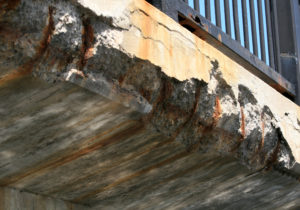We’ve discussed concrete durability in quite a few blog posts, but we’ve only alluded indirectly to concrete service life prediction. Hossam Alalaily explains the basics.
Q: What do you mean by concrete service life?

A: Concrete service life is the length of time the concrete structure is able to serve its intended purpose. In most cases, corrosion of the reinforcing bars is what limits the structure’s service life, as the formation of rust causes expansion and cracking around the rebar. Eventually the surface concrete may spall off altogether, exposing the rebar.
Chloride ions from seawater or deicing salts act as catalysts to the corrosion reactions. Chloride-induced corrosion is the most prevalent form of premature concrete deterioration.
Q: What factors do you consider in predicting concrete service life?
A: We design concrete mixtures to keep the chlorides out—or more accurately, to slow their ingress. Concrete is porous and permeable, so we try to minimize the permeability. We start with a low water-cementitious materials ratio to limit the overall porosity. We include supplementary cementitious materials, which react with calcium hydroxide in the concrete in what we call the pozzolanic reaction. The product, calcium silicate hydrate, takes up more space than the original reactants, so it fills some of the pores. Slag cement also helps by binding the chlorides so they don’t penetrate further into the concrete. Service life models take into account all of these factors.
Tests such as ASTM C1556 and NT Build 492 provide input for service life models in the form of a diffusion coefficient. That is, they show how quickly chlorides can migrate through the concrete.
In addition, a thick cover over the rebar means it takes longer for the chlorides to get to it. That is, it has farther to go before it starts to cause trouble. Cover thickness is an important factor in service life modeling, as it’s the first line of defense.
Q. What assumptions are inherent in the models?
A: Service life prediction models generally consider two main periods: initiation and propagation. During the initiation period, chlorides migrate into the concrete from the outside. When the chloride concentration at the rebar surface reaches the threshold value, we consider that corrosion has initiated. This threshold value is another of the factors we use in modeling concrete service life.
When the chloride concentration at the rebar is high enough to break down the passive layer on the rebar surface, the propagation period begins. That is, the rebar is now actively corroding. We may define the end of the concrete’s service life as when there is no longer enough uncorroded steel left to support the load, or when the concrete cracks and spalls.
LIFE-365 is a computer program that has been designed by the American Concrete Institute to calculate service life. It calculates the initiation period using the concrete cover, mixture proportions, and diffusion coefficient. However, it does not calculate the propagation period. Instead, it assumes a period of 6 years for bare steel and 20 years for epoxy-coated rebar.
Q: How would you use service life prediction in a practical situation?
A: Accurate service life prediction models for reinforced concrete structures help designers and owners achieve cost-effective strategies for design, maintenance, rehabilitation, or replacement. For example, a model can show the difference in service life between a 2-1/2 and 3-inch cover so the owner can see how much it’s worth and compare it to the cost of the additional concrete.
Models can also help the owner can develop the most cost-effective schedule for maintenance and repairs. That’s the best way to maintain the value of the investment.
Determining the remaining service life and potential life-cycle costs could also be part of a prospective buyer’s due diligence.
Repair and maintenance of corroded structures cost billions of dollars per year. Enhancing protection and prediction of service life for reinforcing concrete structures strongly affects economic and ecological sustainability.
